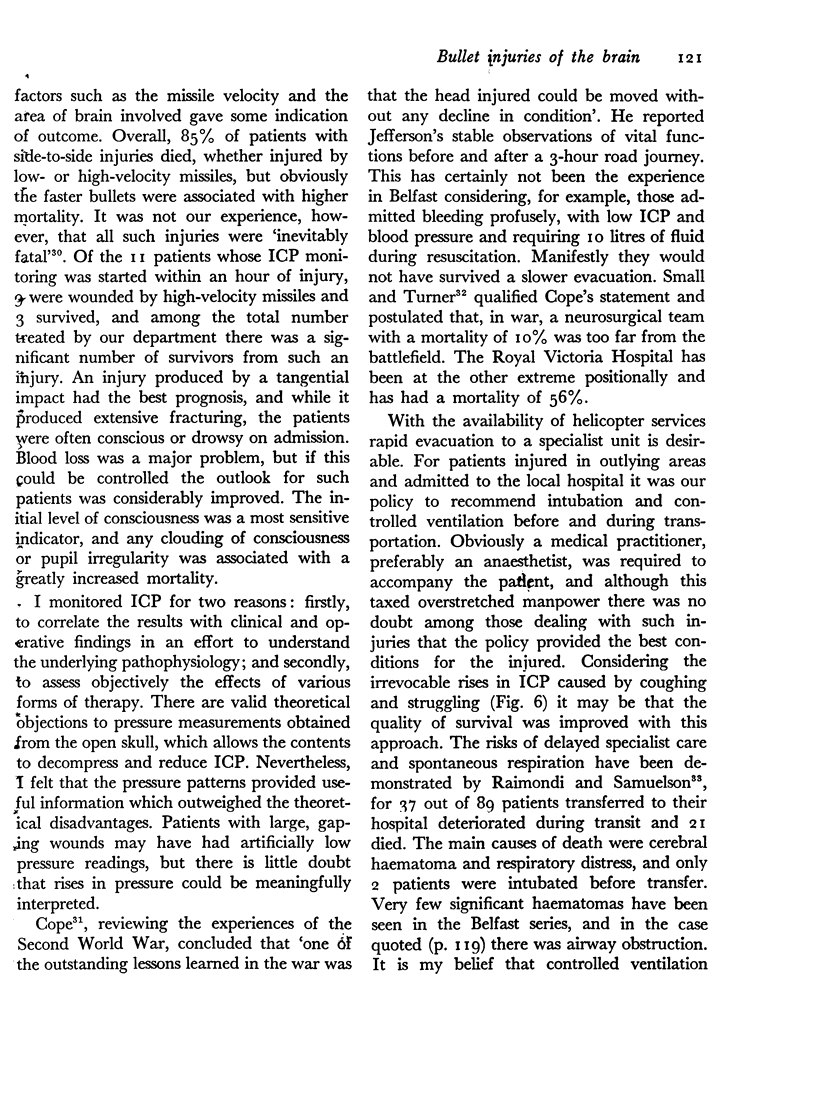Abstract
Experience gained with a wide variety of missile injuries of the brain is presented. Clinical signs and intracranial pressure (ICP) studied in the early post-injury period have been correlated with survival and treatment. Stress is laid on fluid requirements and the importance of controlled ventilation in the management of the labile clinical condition of such patients. Coughing and struggling caused extrusion of blood and brain from the wound, and this was reduced considerably with endotracheal intubation and mechanical ventilation. Post-operatively high ICP could be controlled in potential survivors with continued ventilation.
Full text
PDF












Images in this article
Selected References
These references are in PubMed. This may not be the complete list of references from this article.
- Byrnes D. P., Crockard H. A., Gordon D. S., Gleadhill C. A. Penetrating craniocerebral missile injuries in the civil disturbances in Northern Ireland. Br J Surg. 1974 Mar;61(3):169–176. doi: 10.1002/bjs.1800610302. [DOI] [PubMed] [Google Scholar]
- Crockard H. A., Coppel D. L., Morrow W. F. Evaluation of hyperventilation in treatment of head injuries. Br Med J. 1973 Dec 15;4(5893):634–640. doi: 10.1136/bmj.4.5893.634. [DOI] [PMC free article] [PubMed] [Google Scholar]
- Crockard H. A., Taylor A. R. Serial CSF lactate-pyruvate values as a guide to prognosis in head injury coma. Eur Neurol. 1972;8(1):151–157. doi: 10.1159/000114569. [DOI] [PubMed] [Google Scholar]
- Gerber A. M., Moody R. A. Craniocerebral missile injuries in the monkey: an experimental physiological model. J Neurosurg. 1972 Jan;36(1):43–49. doi: 10.3171/jns.1972.36.1.0043. [DOI] [PubMed] [Google Scholar]
- Hopkinson D. A., Marshall T. K. Firearm injuries. Br J Surg. 1967 May;54(5):344–353. doi: 10.1002/bjs.1800540507. [DOI] [PubMed] [Google Scholar]
- Miller J. D., Garibi J., Pickard J. D. Induced changes of cerebrospinal fluid volume. Effects during continuous monitoring of ventricular fluid pressure. Arch Neurol. 1973 Apr;28(4):265–269. doi: 10.1001/archneur.1973.00490220073011. [DOI] [PubMed] [Google Scholar]
- Raimondi A. J., Samuelson G. H. Craniocerebral gunshot wounds in civilian practice. J Neurosurg. 1970 Jun;32(6):647–653. doi: 10.3171/jns.1970.32.6.0647. [DOI] [PubMed] [Google Scholar]






